Bridging the Construction Productivity Gap—A Hierarchical Framework for the Age of Automation, Robotics, and AI
Abstract
1. Introduction
1.1. Current Status of the Construction Sector
1.2. The Productivity Gap and Its Root Causes
1.3. Productivity Measurement: Existing Approaches and Their Limitations
1.4. Research Contribution: A Hierarchical Framework for Construction Productivity
- Operational Level: Standardised process steps are recorded through Value Stream Mapping (VSM, see Appendix A) and analysed via input efficiency, output effectiveness, and First-Time Quality (FTQ). This granular data foundation enables high-resolution performance diagnostics while preserving traceability across tasks and trades.
- Tactical Level: Takt time compliance, schedule reliability, and workload balance (expressed through the Coefficient of Variation) are used to assess trade synchronisation and production flow stability. These KPIs are synthesised across process clusters and work packages.
- Strategic Level: Broader performance indicators—including flow efficiency and multi-resource utilisation—capture the coordination of trades, disciplines, and modules across spatial and temporal interfaces within the project environment.
- Normative Level: The framework culminates in a composite Overall Productivity Index (OPI), combining quality, efficiency, and effectiveness metrics with sustainability and ESG considerations to inform organisational learning and capital allocation. Relevant ESG indicators—embodied carbon, on-site energy consumption, and social employment metrics—can be integrated into the Overall Productivity Index (OPI) layer. These allow aligning productivity tracking with regulatory and sustainability goals.
- IoT-based real-time sensing;
- Computer vision-enabled activity tracking;
- Agentic AI systems (see Appendix A) capable of autonomous workflow re-sequencing and predictive bottleneck elimination.
2. Historical Context and Current State of the Research Field: Traditional Methods of Productivity Measurement over the Past 100 Years
2.1. Early Scientific Management and Time–Motion Studies (1900s–1920s)
2.2. Gantt Charts and Project Scheduling (1910s–1950s)
2.3. On-Site Observational Methods—Work Sampling and Time Tracking (1940s–1980s)
2.4. Unit Rate Tracking and Early Productivity Standards (1960s–1980s)
2.5. Evolution into Industry Standards and Lean Practices (1990s–2000s)
2.6. Summary of Advantages and Limitations
- Clear expectations via standard time studies and unit rates;
- Structured planning through Gantt charts and CPM;
- Identification of inefficiencies using work sampling and delay analysis;
- High-level tracking through earned value metrics.
3. Review of Existing Productivity Metrics and Frameworks
3.1. Productivity in Construction: Perceptions, Metrics, and Conceptual Foundations
- Labour productivity, typically expressed as output (e.g., value added) per labour hour;
- Capital productivity, which considers the return on equipment and infrastructure investment;
3.2. Measurement Levels and Multi-Scale Productivity Perspectives
- At the task or trade level, metrics focus on specific activities (e.g., cubic meters of concrete poured per crew-hour).
- At the project level, broader indices combine labour and cost metrics to reflect overall efficiency (e.g., square meters delivered per euro or person-day).
- At the industry level, productivity is typically reported through national statistics or macroeconomic surveys based on value added, capital stock, and labour data.
- Planned Productivity (PP): The expected output per planned input;
- Actual Productivity (AP): The realised output per actual input;
- Efficiency (η): The ratio of planned input to actual input, indicating resource use;
- Effectiveness (ε): The ratio of actual output to planned output, indicating goal fulfilment;
- Productivity Index (PI): A composite metric defined as η × ε, integrating both dimensions. Unlike Earned Value Management, which aggregates cost and schedule performance retrospectively, the proposed η × ε framework focuses on real-time process-level efficiency and trade synchronisation.
3.3. Challenges in Standardisation and Data Coherence
- (1)
- Overreliance on Single-Factor Indicators: Labour productivity remains the most frequently cited metric in research and practice, yet it captures only one dimension of performance. A crew may appear more productive in labour terms by increasing equipment usage or material throughput, while total resource efficiency may decline. Hence, labour productivity can be misleading if viewed in isolation, especially in capital- or technology-intensive environments [64].
- (2)
- Activity-Level Myopia and Lack of System View: Productivity metrics often focus on individual trades or isolated tasks (e.g., cubic meters of concrete placed per hour). However, construction outcomes result from interdependent workflows. Gains in one area (e.g., faster rebar placement) can disrupt others (e.g., inspection delays or follow-on trades). This lack of systemic perspective undermines the validity of task-level metrics as proxies for overall project performance [64].
- (3)
- Macro–Micro Disconnect: A well-documented disjunction exists between project-level data and macroeconomic indicators. National or industry-wide productivity reports may show stagnation or decline. In contrast, individual projects report local gains—often due to methodological mismatches in data aggregation, output definitions, or sector-level adjustments [64]. This misalignment hampers policy relevance and undermines trust in reported figures.
- (4)
- Absence of Harmonised Data Infrastructure: Unlike manufacturing, construction lacks centralised reporting platforms for performance data. Measurement practices are typically firm-specific, undocumented, and manually conducted. This lack of structured, interoperable datasets impedes benchmarking, comparison across firms or regions, and broader research on best practices [64].
3.4. Fragmentation, Silo Thinking, and the One-Off Nature of Projects
3.5. External Variability and Systemic Dependencies
3.6. Lessons from Manufacturing: Flow, Modularity, and Standardisation
- Process standardisation to reduce variability and ensure repeatability;
- Modularisation and prefabrication to enable efficient assembly and reduce on-site complexity;
- Automation and robotics to increase throughput and minimise human error;
- Integrated supply chains synchronise material, information, and process flows.
4. A Unified Hierarchical Framework for Productivity Measurement in Construction
4.1. Empirical Validation of Kelly Drilling Using Geiger et al.’s Modular Production Model
4.2. Operational Level
- Benchmarking performance: Actual task durations and resource usage can be compared against standard benchmarks derived from the Value Stream Map (VSM) of a given building component. These benchmarks represent the sum of expected durations for standardised process steps plus idealised logistics times (assumed to be zero in a just-in-time setup). This enables the calculation of performance deviations at the level of individual construction elements.
- Benchmarking productivity: Similarly, productivity can be evaluated as the ratio of the resource input (e.g., labour hours) to the actual output (e.g., installed area or component volume), allowing for quantifiable comparisons of work efficiency across different crews, shifts, or sites.
- Waste identification: Discrepancies between standard and actual sequences (e.g., idle time, rework, and excessive motion) become visible within the process-step model, highlighting bottlenecks and non-value-adding activities for elimination.
- Transfer of best practices: Because a process step such as “pour concrete” is identically defined across projects, successful strategies and learned optimisations from one site can be directly transferred to another, reinforcing organisational learning.
4.3. Tactical Level (or Trade Level)
- Horizontal productivity is calculated along the process axis. It aggregates the cycle times and First-Time Quality scores of the standardised process steps that form a single building component (e.g., one bored pile or one drywall partition).
- Vertical productivity is measured along the operational axis. It sums the performance of all construction elements produced by one trade within a defined zone or takt window, yielding the overall productivity of a construction module (e.g., an entire bored-pile wall or a completed apartment floor).
4.4. Strategic Level (or Building Section or Building)
4.5. Normative Level (or Project Management or Level)
5. Discussion and Future Outlook
5.1. Future Research Directions
- Empirical validation of the hierarchical framework across diverse project typologies (e.g., high-rise, infrastructure, and modular housing), procurement models, and geographic contexts.
- Integration with digital twins and IoT-based observability, enabling bi-directional feedback between physical construction processes and virtual planning/control environments.
- Deployment of agentic AI systems that leverage the hierarchical KPI structure to detect deviations, trigger learning loops, and optimise workflows autonomously, while maintaining traceability and human oversight.
- Potential exploration of exponential technologies in construction, such as smart contracts and blockchain integration for linking real-time productivity data to contractual milestones, payment systems, and performance-based incentives.
- Development of interoperability standards to bridge heterogeneous platforms (e.g., BIM, ERP, and site sensors) through API harmonisation and standard data ontologies. This also aligns with recent initiatives in platform-based industrialisation and open data models such as IFC 4.3 [107] and ISO 19650 [108], which seek to harmonise productivity data across construction ecosystems.
- Address implementation challenges by promoting low-code automation tools and federated platform architectures, enabling incremental adoption by SMEs and avoiding vendor lock-in.
- Cultural and organisational change frameworks to overcome resistance to automation, standardisation, and the shift from intuition-based to data-driven project management.
- The proposed framework can serve as a blueprint for digital construction standards, productivity-linked contracts, and AI integration strategies at the firm and industry levels. We recommend its inclusion in sectoral modernisation roadmaps, such as those currently pursued under national productivity missions, construction industrialisation plans, or EU digital twin programs.
5.2. Towards the Future of Intelligent Construction
5.3. Conclusion: A New Paradigm for Construction Productivity
5.4. Limitations and Future Work
- Inter-project comparability of standardised process steps remains a methodological and organisational challenge across heterogeneous firms and delivery models. The potential tension between standardisation and the bespoke nature of architectural design intent may require careful reconciliation between performance optimisation and aesthetic/functional diversity.
- Integration with legacy IT ecosystems and fragmented data silos may require transitional interfaces, change management processes, and phased strategies.
- Cultural resistance to automation, standardisation, and performance transparency may constrain adoption, particularly in traditionally managed organisations.
Author Contributions
Funding
Data Availability Statement
Acknowledgments
Conflicts of Interest
Abbreviations
| AI | Artificial Intelligence |
| BEA | Bureau of Economic Analysis |
| BIM | Building Information Modelling |
| CICE | Construction Industry Cost Effectiveness |
| CPI | Cost Performance Index |
| CPM | Critical Path Method |
| CV | Coefficient of Variation |
| ESG | Environmental, Social, and Governance |
| EVM | Earned Value Management |
| FTE | Full Time Equivalent |
| FTQ | First-Time Quality |
| HIC | Human-in-Command |
| IoT | Internet of Things |
| LiDAR | Light Detection and Ranging |
| MPDM | Method Productivity Delay Model |
| OPI | Overall Productivity Index |
| PERT | Program Evaluation and Review Technique |
| R&D | Research and Development |
| ROI | Return on Investment |
| SPI | Schedule Performance Index |
| TFP | Total Factor Productivity |
| VSM | Value Stream Mapping |
Appendix A
Definition of Key Concepts and Terms
References
- Farmer, M. The Farmer Review of the UK Construction Labour Model “Modernize or Die-Time to Decide the Industry’s Future”. Available online: http://www.constructionleadershipcouncil.co.uk/wp-content/uploads/2016/10/Farmer-Review.pdf (accessed on 16 January 2025).
- Barbosa, F.; Woetzel, J.; Mischke, J. Reinventing Construction: A Route of Higher Productivity; McKinsey Global Institute: New York, NY, USA, 2017. [Google Scholar]
- Barbosa, F.; Mischke, J.; Parsons, M. Improving Construction Productivity. Available online: https://www.mckinsey.com/capabilities/operations/our-insights/improving-construction-productivity (accessed on 20 July 2025).
- Goolsbee, A.; Syverson, C. The Strange and Awful Path of Productivity in the US Construction Sector; National Bureau of Economic Research: Cambridge, MA, USA, 2023. [Google Scholar]
- Mischke, J.; Stokvis, K.; Vermeltfoort, K.; Biemans, B. Delivering on Construction Productivity Is No Longer Optional; McKinsey & Company: New York, NY, USA, 2024; Volume 15, Available online: https://www.mckinsey.com/capabilities/operations/our-insights/delivering-on-construction-productivity-is-no-longer-optional (accessed on 12 August 2025).
- Hossain, M.; Ng, S.; Antwi-Afari, P.; Amor, B. Circular economy and the construction industry: Existing trends, challenges and prospective framework for sustainable construction. Renew. Sustain. 2020, 130, 109948. [Google Scholar] [CrossRef]
- Yang, M.; Chen, L.; Wang, J.; Msigwa, G.; Osman, A.; Fawzy, S.; Rooney, D.W.; Yap, P.-S. Circular economy strategies for combating climate change and other environmental issues. Environ. Chem. Lett. 2023, 21, 55–80. [Google Scholar] [CrossRef]
- Xie, X.; Li, H.; Cheng, B.; Li, F.; Mikkilä, M. Global Value Chain Embedding and Total Factor Productivity in Carbon Emission Reduction: A Multi-Country Analysis of the Paper Industry. Forests 2025, 16, 222. [Google Scholar] [CrossRef]
- World Economic Forum (WEF). Shaping the Future of Construction: A Breakthrough in Mindset and Technology; World Economic Forum: Cologny, Switzerland, 2016. [Google Scholar]
- Ballard, G.; Howell, G. Shielding production: Essential step in production control. J. Constr. Eng. Manag. 1998, 124, 11–17. [Google Scholar] [CrossRef]
- Koskela, L. An Exploration Towards a Production Theory and Its Application to Construction; VTT Technical Research Centre of Finland: Espoo, Finland, 2000. [Google Scholar]
- World Economic Forum (WEF). Shaping the Future of Construction—An Action Plan to Solve the Industry’s Talent Gap; World Economic Forum: Cologny, Switzerland, 2018. [Google Scholar]
- Bühler, M.M.; Jelinek, T.; Nübel, K. Training and Preparing Tomorrow’s Workforce for the Fourth Industrial Revolution. Educ. Sci. 2022, 12, 782. [Google Scholar] [CrossRef]
- Alejo, A.; Aigbavboa, C.; Aghimien, D. Emerging Trends of Safe Working Conditions in the Construction Industry: A Bibliometric Approach. Buildings 2024, 14, 2790. [Google Scholar] [CrossRef]
- Elbashbishy, T.; El-adaway, I. Assessing the Impact of Skilled Labor Shortages on Project Cost Performance. In Proceedings of the Construction Research Congress 2024, Des Moines, IA, USA, 20–23 March 2024; pp. 361–370. [Google Scholar] [CrossRef]
- Syverson, C. Challenges to mismeasurement explanations for the US productivity slowdown. J. Econ. Perspect. 2017, 31, 165–186. [Google Scholar] [CrossRef]
- Oglesby, C.; Parker, H.; Howell, G. Productivity Improvement in Construction. In McGraw-Hill Series in Construction Engineering and Project Management; McGraw-Hill: New York, NY, USA, 1989; 588p, ISBN 0070478031, 9780070478039. [Google Scholar]
- Thomas, H.R.; Kramer, D.F. Definition of Productivity. In The Manual of Construction Productivity Measurement and Performance Evaluation; Publication SD-35; Construction Industry Institute: Austin, TX, USA, 1988. [Google Scholar]
- Clark, W. The Gantt Chart: A Working Tool of Management; Ronald Press Company, New York Public Library: New York, NY, USA, 1922. [Google Scholar]
- Hinze, J. Construction Planning and Scheduling; Pearson Education: London, UK, 2012. [Google Scholar]
- Fleming, Q.; Koppelman, J. Earned Value Project Management; Project Management Institute: Newtown Square, PA, USA, 2016. [Google Scholar]
- Hines, P.; Tortorella, G.L.; Antony, J.; Romero, D. Lean Industry 4.0: Past, present, and future. Qual. Manag. J. 2023, 30, 64–88. [Google Scholar] [CrossRef]
- Ballard, G. The Lean Project Delivery System: An Update. Lean Constr. J. 2008, 2008, 1–19. [Google Scholar] [CrossRef]
- Ballard, G.; Howell, G. Lean project management. Build. Res. Inf. 2003, 31, 119–133. [Google Scholar] [CrossRef]
- Howell, G. What Is Lean Construction-1999; Citeseer: Princeton, NJ, USA, 1999. [Google Scholar]
- Koskela, L.; Howell, G.; Ballard, G.; Tommelein, I. The foundations of lean construction. In Design and Construction; Taylor Francis Group: Abingdon, UK, 2007. [Google Scholar]
- Ballard, G.; Howell, G. Implementing lean construction: Stabilizing work flow. In Lean Construction; CRC Press: Boca Raton, FL, USA, 1994. [Google Scholar]
- Frandson, A.; Berghede, K.; Tommelein, I. Takt time planning for construction of exterior cladding. In Proceedings of the 21st Annual Conference of the International Group for Lean Construction, Fortaleza, Brazil, 29 July–2 August 2013. [Google Scholar]
- Hamledari, H.; Fischer, M. Construction payment automation using blockchain-enabled smart contracts and robotic reality capture technologies. Autom. Constr. 2021, 132, 103926. [Google Scholar] [CrossRef]
- Alzubi, K.; Alaloul, W.; Malkawi, A.; Al Salaheen, M.; Qureshi, A.H.; Musarat, M.A. Automated monitoring technologies and construction productivity enhancement: Building projects case. Ain Shams Eng. J. 2022, 14, 102042. [Google Scholar] [CrossRef]
- Teizer, J.; Wolf, M.; Golovina, O.; Perschewski, M.; Propach, M.; Neges, M.; König, M.N.A.M. Internet of Things (IoT) for integrating environmental and localization data in Building Information Modeling (BIM). In Proceedings of the 34th International Symposium on Automation and Robotics in Construction (ISARC), Taipei, Taiwan, 28 June–1 July 2017; pp. 603–609. [Google Scholar]
- Banitaan, S.; Al-Refai, G.; Almatarneh, S.; Alquran, H. A Review on Artificial Intelligence in the Context of Industry 4.0. Int. J. Adv. Comput. Sci. Appl. 2023, 14, 23–30. [Google Scholar] [CrossRef]
- Kwak, E. Automatic 3D Building Model Generation by Integrating LiDAR and Aerial Images Using a Hybrid Approach; University of Calgary: Calgary, AB, Canada, 2013. [Google Scholar]
- Gubbi, J.; Buyya, R.; Marusic, S.; Palaniswami, M. Internet of Things (IoT): A vision, architectural elements, and future directions. Future Gener. Comput. Syst. 2013, 29, 1645–1660. [Google Scholar] [CrossRef]
- Jeon, Y.; Kulinan, A.; Kim, T.; Park, M.; Park, S. Vision-based motion prediction for construction workers safety in real-time multi-camera system. Adv. Eng. Informatics 2024, 62, 102898. [Google Scholar] [CrossRef]
- Morales, J.N. AI-Driven Project Controls: Integrated Computer Vision Production Tracking &AI-Driven Forecasting in Building Construction. Ph.D. Thesis, University of Illinois at Urbana-Champaign, Champaign, IL, USA, 2024. [Google Scholar]
- Xu, S.; Wang, J.; Shou, W.; Ngo, T.; Sadick, A.; Wang, X. Computer vision techniques in construction: A critical review. Arch. Comput. Methods Eng. 2021, 28, 3383–3397. [Google Scholar] [CrossRef]
- Yang, J.; Wilde, A.; Menzel, K.; Sheikh, M.; Kuznetsov, B. Computer vision for construction progress monitoring: A real-time object detection approach. In Working Conference on Virtual Enterprises; Springer: Berlin/Heidelberg, Germany, 2023; pp. 660–672. [Google Scholar] [CrossRef]
- Nghiem, T.X.; Drgoňa, J.; Jones, C.; Nagy, Z.; Schwan, R.; Dey, B.; Chakrabarty, A.; Di Cairano, S.; Paulson, J.A.; Carron, A.; et al. Physics-Informed Machine Learning for Modeling and Control of Dynamical Systems. arXiv 2023, arXiv:2306.13867. [Google Scholar] [CrossRef]
- Boiko, A. Big Data and Machine Learning. Practical Step-by-Step Course for Beginners. Available online: https://bigdataconstruction.com/ (accessed on 15 November 2022).
- Casini, M. Construction 4.0: Advanced Technology, Tools and Materials for the Digital Transformation of the Construction Industry; Woodhead Publishing: New Delhi, Delhi, 2021. [Google Scholar]
- Kumar, S. System and Method for Computational Simulation and Augmented/Virtual Reality in a Construction Environment. U.S. Patent 11,907,885, 20 February 2024. [Google Scholar]
- Liang, R.; Huang, C.; Zhang, C.; Li, B.; Saydam, S.; Canbulat, I. Exploring the fusion potentials of data visualization and data analytics in the process of mining digitalization. IEEE Access 2023, 11, 40608–40628. [Google Scholar] [CrossRef]
- Chen, Y.; Huang, D.; Liu, Z.; Osmani, M.; Demian, P. Construction 4.0, Industry 4.0, and Building Information Modeling (BIM) for sustainable building development within the smart city. Sustainability 2022, 14, 10028. [Google Scholar] [CrossRef]
- Bock, T.; Linner, T. Robot Oriented Design; Cambridge University Press: Cambridge, UK, 2015. [Google Scholar]
- Pan, Y.; Zhang, L. Integrating BIM and AI for smart construction management: Current status and future directions. Arch. Comput. Methods Eng. 2023, 30, 1081–1110. [Google Scholar] [CrossRef]
- Pan, Y.; Zhang, L. Roles of artificial intelligence in construction engineering and management: A critical review and future trends. Autom. Constr. 2021, 122, 103517. [Google Scholar] [CrossRef]
- Farmer, E. Time and Motion Study; HM Stationery Office: London, UK, 1921. [Google Scholar]
- Gilbreth, F. Bricklaying System; University of Michigan: Ann Arbor, MI, USA, 1909. [Google Scholar]
- Gantt, H. Work, Wages, and Profits; Engineering Magazine Company: New York, NY, USA, 1913. [Google Scholar]
- Gantt, H. Organizing for Work; Harcourt, Brace and Howe: San Diego, CA, USA, 1919. [Google Scholar]
- Adrian, J.; Boyer, L. Modeling method-productivity. J. Constr. Div. 1976, 102, 157–168. [Google Scholar] [CrossRef]
- Syverson, C. What determines productivity? J. Econ. Lit. 2011, 49, 326–365. [Google Scholar] [CrossRef]
- Modig, N.; Åhlström, P. This Is Lean: Resolving the Efficiency Paradox; Rheologica: Stockholm, Sweden, 2012. [Google Scholar]
- Arcari, E.; Minniti, M.V.; Scampicchio, A.; Carron, A.; Farshidian, F.; Hutter, M.; Zeilinger, M.N. Bayesian multi-task learning MPC for robotic mobile manipulation. IEEE Robot. Autom. Lett. 2023, 8, 3222–3229. [Google Scholar] [CrossRef]
- Ghanbari, J.; Zare, M. Review of Automation and Robotic in Advanced Construction Methods: A Case Study of Karaksa Hotel. New Approaches Civ. Eng. 2021, 5, 1–16. [Google Scholar]
- Bock, T. The future of construction automation: Technological disruption and the upcoming ubiquity of robotics. Autom. Constr. 2015, 59, 113–121. [Google Scholar] [CrossRef]
- Ayele, S.; Fayek, A. A framework for total productivity measurement of industrial construction projects. Can. J. Civ. Eng. 2019, 46, 195–206. [Google Scholar] [CrossRef]
- Sacks, R.; Eastman, C.; Lee, G.; Teicholz, P. BIM Handbook: A Guide to Building Information Modeling for Owners, Designers, Engineers, Contractors, and Facility Managers; John Wiley & Sons: Hoboken, NJ, USA, 2018. [Google Scholar]
- Dave, B.; Kubler, S.; Främling, K.; Koskela, L. Opportunities for enhanced lean construction management using Internet of Things standards. Autom. Constr. 2016, 61, 86–97. [Google Scholar] [CrossRef]
- Borrmann, A.; König, M.; Koch, C.; Beetz, J. Building Information Modeling: Why? What? How? Springer: Berlin/Heidelberg, Germany, 2018. [Google Scholar]
- Dixit, S.; Sharma, K. An empirical study of major factors affecting productivity of construction projects. In Emerging Trends in Civil Engineering: Select Proceedings of ICETCE 2018; Springer: Singapore, 2020; pp. 121–129. [Google Scholar] [CrossRef]
- Sawhney, A.; Rubinsohn, S.; Luo, D. RICS Construction Productivity Report 2024. Available online: https://www.rics.org/news-insights/rics-construction-productivity-report-2024 (accessed on 11 May 2025).
- Rathnayake, A.; Middleton, C. Systematic review of the literature on construction productivity. J. Constr. Eng. Manag. 2023, 149, 03123005. [Google Scholar] [CrossRef]
- Shan, M.; Li, Y.; Hwang, B.; Chua, J. Productivity metrics and its implementations in construction projects: A case study of Singapore. Sustainability 2021, 13, 12132. [Google Scholar] [CrossRef]
- Teicholz, P. Labor productivity declines in the construction industry: Causes and remedies. AECbytes Viewp. 2004, 67, 15. [Google Scholar]
- Sacks, R.; Brilakis, I.; Pikas, E.; Xie, H.; Girolami, M. Construction with digital twin information systems. Data-Centric Eng. 2020, 1, e14. [Google Scholar] [CrossRef]
- Sacks, R.; Girolami, M.; Brilakis, I. Building Information Modelling, Artificial Intelligence and Construction Tech; Elsevier: Amsterdam, The Netherlands, 2020. [Google Scholar]
- Allen, C.; Shakantu, W. The BIM revolution: A literature review on rethinking the business of construction. WIT Trans. Ecol. Environ. 2016, 204, 919–930. [Google Scholar] [CrossRef]
- Zupancic, T.; Bühler, M.; Kosta, I.; Dakhil, H. An Action Plan to Accelerate Building Information Modeling (BIM) Adoption; World Economic Forum: Cologny, Switzerland, 2018; Available online: https://www3.weforum.org/docs/WEF_Accelerating_BIM_Adoption_Action_Plan.pdf (accessed on 12 August 2025).
- Dubois, A.; Gadde, L. The construction industry as a loosely coupled system: Implications for productivity and innovation. Constr. Manag. Econ. 2002, 20, 621–631. [Google Scholar] [CrossRef]
- Winch, G. Managing Construction Projects; John Wiley & Sons: Hoboken, NJ, USA, 2012. [Google Scholar]
- Love, P.; Gunasekaran, A. Concurrent engineering in the construction industry. Concurr. Eng. 1997, 5, 155–162. [Google Scholar] [CrossRef]
- Antunes, R.; Poshdar, M. Envision of an integrated information system for project-driven production in construction. arXiv 2018, arXiv:1807.04966. [Google Scholar] [CrossRef]
- Antunes, R.; Gonzalez, V. A production model for construction: A theoretical framework. Buildings 2015, 5, 209–228. [Google Scholar] [CrossRef]
- Soliman, M.; Saurin, T.A. Lean-as-imagined differs from lean-as-done: The influence of complexity. Prod. Plan. Control. 2022, 33, 1097–1114. [Google Scholar] [CrossRef]
- Howell, G.; Ballard, G.; Demirkesen, S. Why Lean Projects are Safer. In Proceedings of the 25th Annual Conference of the International Group for Lean Construction, Heraklion, Greece, 9–12 July 2017; pp. 4–12. [Google Scholar]
- Salem, O.; Solomon, J.; Genaidy, A.; Minkarah, I. Lean construction: From theory to implementation. J. Manag. Eng. 2006, 22, 168–175. [Google Scholar] [CrossRef]
- Elghaish, F.; Abrishami, S.; Hosseini, M.R. Integrated project delivery with blockchain: An automated financial system. Autom. Constr. 2020, 114, 103182. [Google Scholar] [CrossRef]
- Zhang, L.; He, J.; Zhou, S. Sharing tacit knowledge for integrated project team flexibility: Case study of integrated project delivery. J. Constr. Eng. Manag. 2013, 139, 795–804. [Google Scholar] [CrossRef]
- Kent, D.C.; Becerik-Gerber, B. Understanding construction industry experience and attitudes toward integrated project delivery. J. Constr. Eng. Manag. 2010, 136, 815–825. [Google Scholar] [CrossRef]
- Buehler, M.; Buffet, R.; Castagnino, S. The Fourth Industrial Revolution is About to Hit the Construction Industry. Here’s How it Can Thrive. In Proceedings of the World Economic Forum Agenda, Davos, Switzerland, 29 January 2021; Available online: https://www.weforum.org/stories/2018/06/construction-industry-future-scenarios-labour-technology/ (accessed on 12 August 2025).
- Hijazi, A.A.; Perera, S.; Calheiros, R.N.; Alashwal, A. A data model for integrating BIM and blockchain to enable a single source of truth for the construction supply chain data delivery. Eng. Constr. Arch. Manag. 2022, 30, 4645–4664. [Google Scholar] [CrossRef]
- Schuldt, S.; Nicholson, M.; Adams, Y.; Delorit, J. Weather-related construction delays in a changing climate: A systematic state-of-the-art review. Sustainability 2021, 13, 2861. [Google Scholar] [CrossRef]
- Dong, R.; Muhammad, A.; Nauman, U. The Influence of Weather Conditions on Time, Cost, and Quality in Successful Construction Project Delivery. Buildings 2025, 15, 474. [Google Scholar] [CrossRef]
- Pryke, S. Successful Construction Supply Chain Management: Concepts and Case Studies; John Wiley & Sons: Hoboken, NJ, USA, 2020. [Google Scholar]
- Zhang, G.; Yang, Y.; Yang, G. Smart supply chain management in Industry 4.0: The review, research agenda and strategies in North America. Ann. Oper. Res. 2023, 322, 1075–1117. [Google Scholar] [CrossRef]
- D’Amico, L.; Glaeser, E.; Gyourko, J.; Kerr, W.; Ponzetto, G.A.M. Why Has Construction Productivity Stagnated? The Role of Land-Use Regulation; National Bureau of Economic Research: New York, NY, USA, 2024. [Google Scholar]
- Womack, J.; Jones, D.; Roos, D. The Machine that Changed the World: The Story of Lean Production--Toyota’s Secret Weapon in the Global Car Wars That Is Now Revolutionizing World Industry; Simon and Schuster: New York, NY, USA, 2007. [Google Scholar]
- Smith, P. BIM Implementation–Global Strategies. Procedia Eng. 2014, 85, 482–492. [Google Scholar] [CrossRef]
- Ouda, E.; Haggag, M. Automation in Modular Construction Manufacturing: A Comparative Analysis of Assembly Processes. Sustainability 2024, 16, 9238. [Google Scholar] [CrossRef]
- Conte, M.; Echeveste, M.; Formoso, C.; Bazzan, J. Synergies between Mass Customisation and Construction 4.0 Technologies. Buildings 2022, 12, 1896. [Google Scholar] [CrossRef]
- Ng, M.; Graser, K.; Hall, D. Digital fabrication, BIM and early contractor involvement in design in construction projects: A comparative case study. Archit. Eng. Des. Manag. 2021, 19, 39–55. [Google Scholar] [CrossRef]
- Bühler, M.; Hollenbach, P.; Michalski, A.; Meyer, S.; Birle, E.; Off, R.; Lang, C.; Schmidt, W.; Cudmani, R.; Fritz, O.; et al. The industrialisation of sustainable construction: A transdisciplinary approach to the large-scale introduction of compacted mineral mixtures (CMMs) into Building Construction. Sustainability 2023, 15, 10677. [Google Scholar] [CrossRef]
- Geiger, M.; Schlicke, M.; Yang, B.; Nübel, K. Framework of an Implementation Strategy for a Modular Construction Toolkit Design in Construction Companies. J. Inf. Syst. Eng. Manag. 2025, 10, 34. [Google Scholar] [CrossRef]
- Shingo, S. Non-Stock Production: The Shingo System of Continuous Improvement; CRC Press: Boca Raton, FL, USA, 1988. [Google Scholar]
- Shingo, S. Zero Quality Control: Source Inspection and the Poka-Yoke System; Taylor Francis Group: Abingdon, UK, 2021. [Google Scholar]
- Shingo, S.; Dillon, A. A Study of the Toyota Production System: From an Industrial Engineering Viewpoint; Taylor Francis Group: Abingdon, UK, 2019. [Google Scholar]
- Bühler, M.; Hollenbach, P.; Köhler, L.; Armstrong, R. Unlocking resilience and sustainability with earth-based materials: A principled framework for urban transformation. Front. Built Environ. 2024, 10, 1385116. [Google Scholar] [CrossRef]
- Vögt, V.; Harrs, J.; Reinhart, V.; Hollenbach, P.; Bühler, M.; Tewes, T. Implementing agile data workflows to unlock climate-resilient urban planning. Climate 2023, 11, 174. [Google Scholar] [CrossRef]
- Liker, J. The Toyota Way: 14 Management Principles from the World’s Greatest Manufacturer; McGraw-Hill: New York, NY, USA, 2020. [Google Scholar]
- Imai, M. Kaizen: The Key to Japan’s Competitive Success; Random House Business Division: New York, NY, USA, 1986. [Google Scholar]
- Rother, M.; Shook, J. Value-Stream Mapping to Create Value and Eliminate Muda; The Lean Enterprise Institute: Brookline, MA, USA, 1999. [Google Scholar]
- Womack, J.; Jones, D. Lean thinking—Banish waste and create wealth in your corporation. J. Oper. Res. Soc. 1997, 48, 1148. [Google Scholar] [CrossRef]
- Ohno, T. Toyota Production System: Beyond Large-Scale Production; Taylor Francis Group: Abingdon, UK, 1988. [Google Scholar]
- Ballard, H. The Last Planner System of Production Control. Ph.D. Thesis, University of Birmingham, Birmingham, UK, 2000. [Google Scholar]
- ISO 16739-1:2024; Industry Foundation Classes (IFC) for Data Sharing in the Construction and Facility Management Industries—Part 1: Data schema. International Organization for Standardization (ISO): Geneva, Switzerland, 2024.
- ISO 19650-1:2018; Organization and Digitization of Information about Buildings and Civil Engineering Works, Including Building Information Modelling (BIM)—Information Management Using Building Information Modelling—Part 1: Concepts and Principles. International Organization for Standardization (ISO): Geneva, Switzerland, 2018.

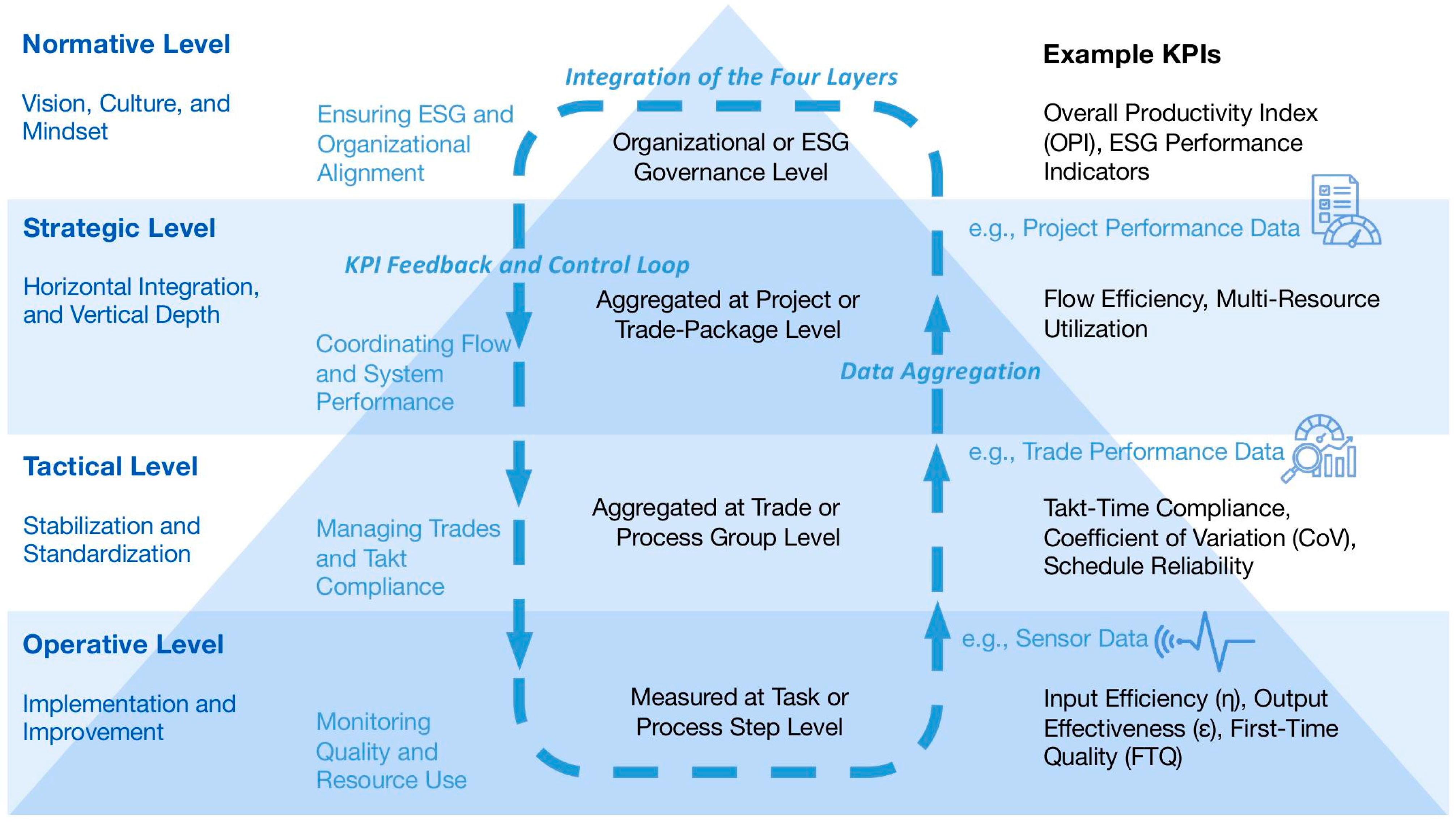

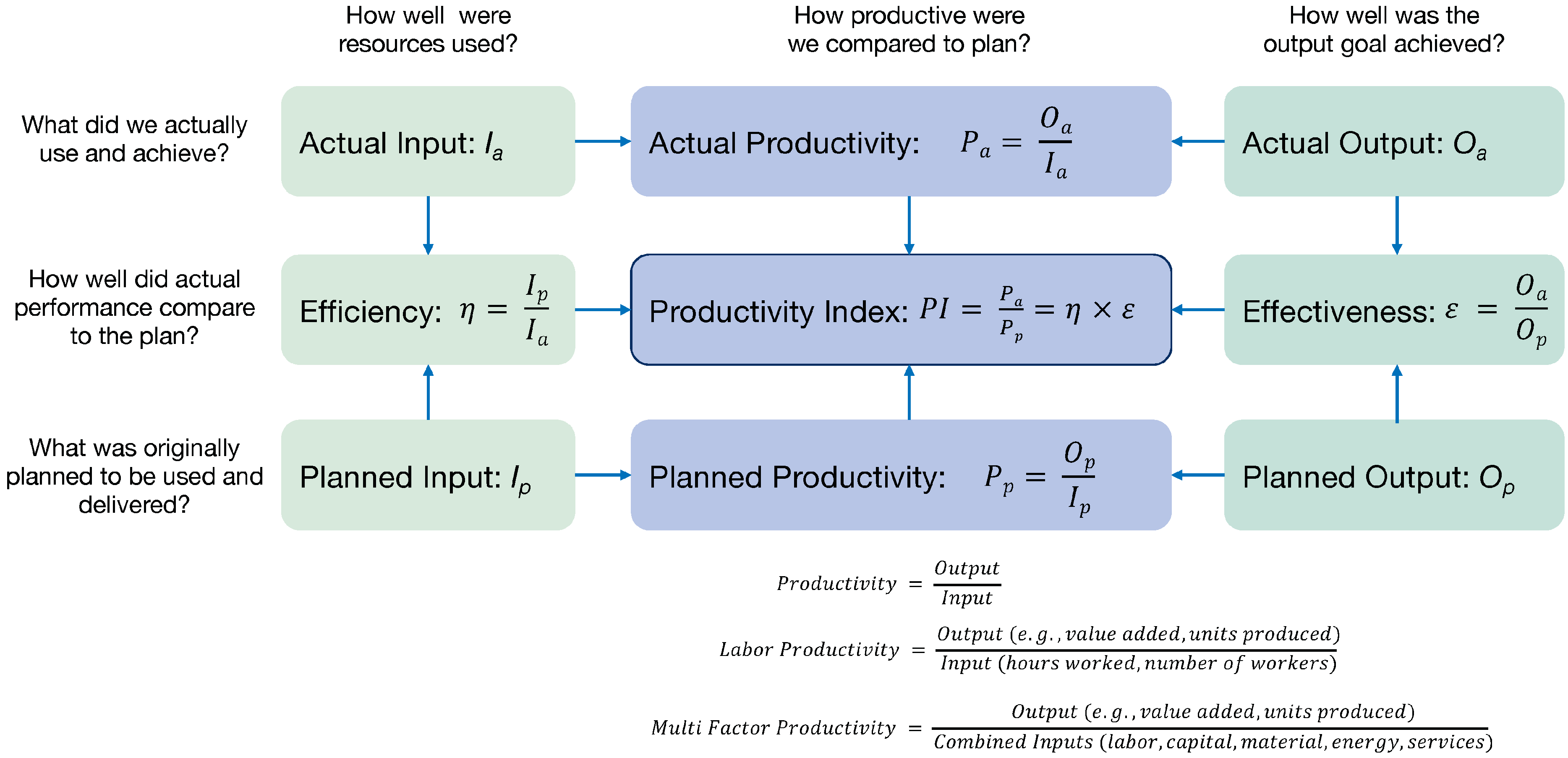
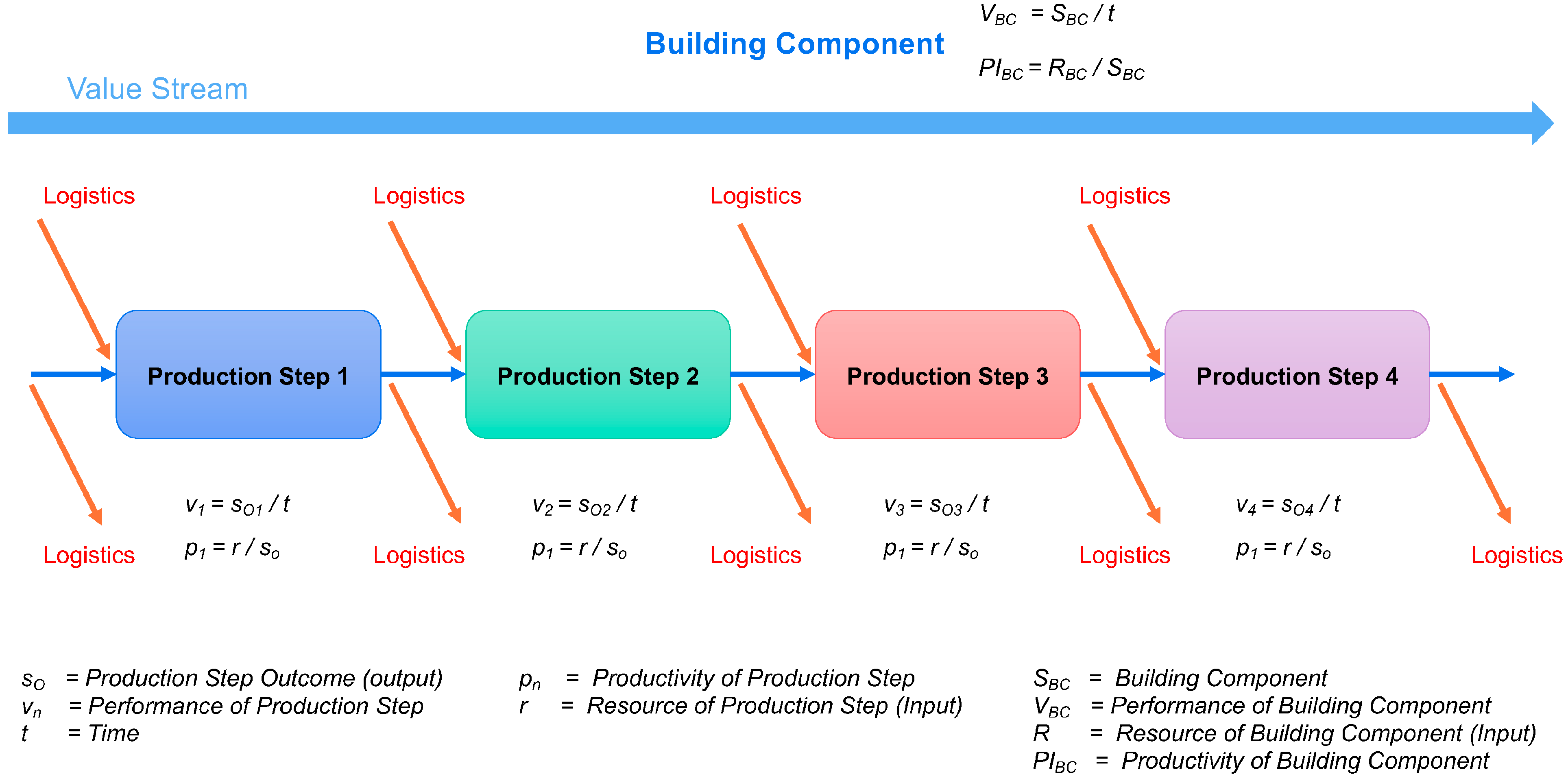
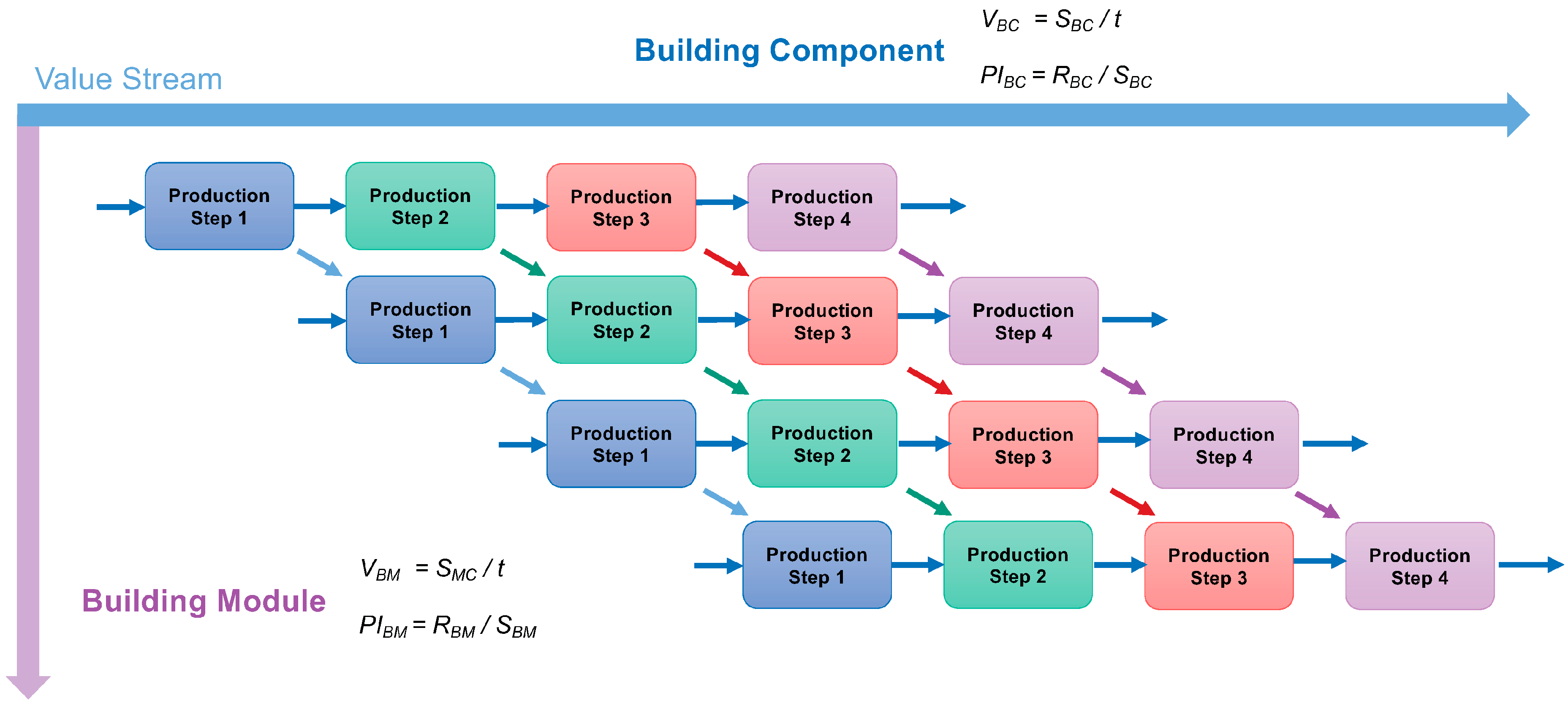

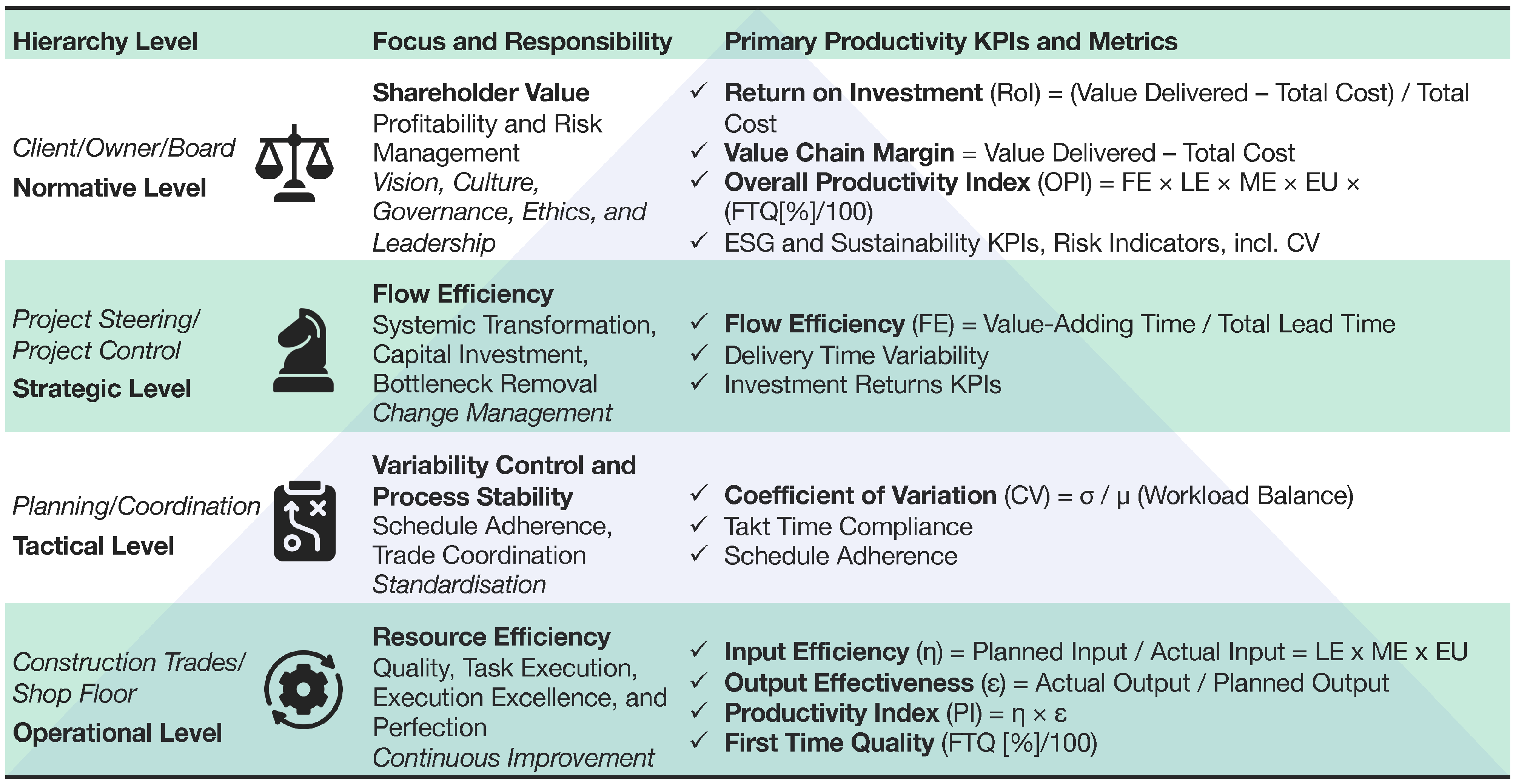
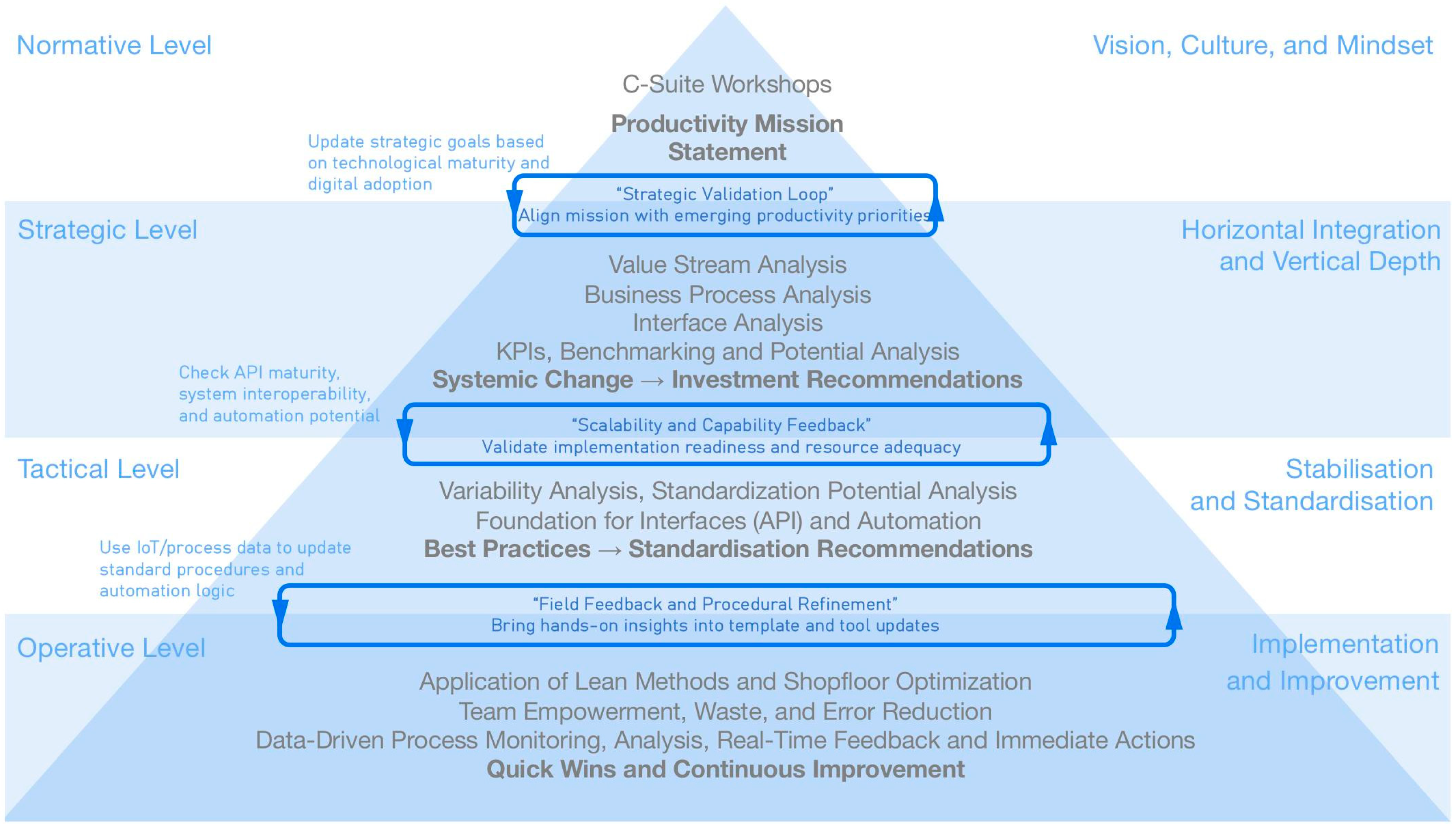
Disclaimer/Publisher’s Note: The statements, opinions and data contained in all publications are solely those of the individual author(s) and contributor(s) and not of MDPI and/or the editor(s). MDPI and/or the editor(s) disclaim responsibility for any injury to people or property resulting from any ideas, methods, instructions or products referred to in the content. |
© 2025 by the authors. Licensee MDPI, Basel, Switzerland. This article is an open access article distributed under the terms and conditions of the Creative Commons Attribution (CC BY) license (https://creativecommons.org/licenses/by/4.0/).
Share and Cite
Bühler, M.M.; Nübel, K.; Jelinek, T.; Köhler, L.; Hollenbach, P. Bridging the Construction Productivity Gap—A Hierarchical Framework for the Age of Automation, Robotics, and AI. Buildings 2025, 15, 2899. https://doi.org/10.3390/buildings15162899
Bühler MM, Nübel K, Jelinek T, Köhler L, Hollenbach P. Bridging the Construction Productivity Gap—A Hierarchical Framework for the Age of Automation, Robotics, and AI. Buildings. 2025; 15(16):2899. https://doi.org/10.3390/buildings15162899
Chicago/Turabian StyleBühler, Michael Max, Konrad Nübel, Thorsten Jelinek, Lothar Köhler, and Pia Hollenbach. 2025. "Bridging the Construction Productivity Gap—A Hierarchical Framework for the Age of Automation, Robotics, and AI" Buildings 15, no. 16: 2899. https://doi.org/10.3390/buildings15162899
APA StyleBühler, M. M., Nübel, K., Jelinek, T., Köhler, L., & Hollenbach, P. (2025). Bridging the Construction Productivity Gap—A Hierarchical Framework for the Age of Automation, Robotics, and AI. Buildings, 15(16), 2899. https://doi.org/10.3390/buildings15162899








